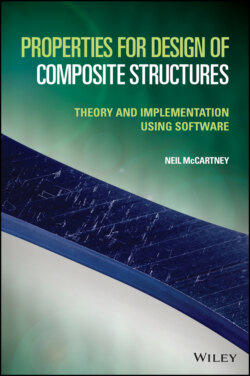Читать книгу Properties for Design of Composite Structures - Neil McCartney - Страница 49
3.2.3 Maxwell’s Methodology for Estimating Conductivity
ОглавлениеThe first step of Maxwell’s approach considers the effect of embedding in the infinite isotropic matrix, an isolated cluster of isotropic spherical particles of different types that can be just contained within a sphere of radius b, as illustrated in Figure 3.1(a). The isotropic thermal conductivity of particles of type i is denoted by κp(i). The cluster is assumed to be effectively homogeneous regarding the distribution of particles, leading to an isotropic effective thermal conductivity κeff for the composite lying within the sphere of radius b. For a single particle, the matrix temperature distribution is perturbed from the distribution (3.4) to the distribution (3.6) that depends on particle geometry and properties. The perturbing effect in the matrix at large distances from the cluster of particles is estimated by superimposing the perturbations caused by each spherical particle, regarded as being isolated. The second step recognises that, at very large distances from the cluster, all the particles can be considered located at the origin that is chosen to be situated at the centre of one of the particles in the cluster. Thus, for the case of multiple phases, the approximate temperature distribution in the matrix at large distances from the cluster is given by the following generalisation of the second of relations (3.6):
(3.7)
On using (3.1), this relation may be expressed in terms of the volume fractions so that
(3.8)
The third step involves replacing the composite having discrete particles lying within the sphere of radius b by a homogeneous spherical isotropic effective medium (see Figure 3.1(b)) having radius b and having the isotropic effective thermal conductivity κeff of the composite. On using (3.6), the temperature distribution in the matrix outside the sphere of effective medium having radius b is then given exactly, for a given value of κeff, by
(3.9)
If the cluster in Figure 3.1(a) is represented accurately by the effective medium shown in Figure 3.1(b), then, at large distances from the cluster, the temperature distributions (3.8) and (3.9) should be identical, leading to the fourth step, where the perturbation terms in relations (3.8) and (3.9) are equated, so that
(3.10)
which is a ‘mixtures’ relation for the quantity 1/(κ+2κm). On using (3.1), the effective thermal conductivity may be estimated using
(3.11)
For multiphase composites, Hashin and Shtrikman [5, Equations (3.21)–(3.23)] derived bounds for magnetic permeability, pointing out that they are analogous to bounds for effective thermal conductivity. Their conductivity bounds may be expressed in the following simpler form, having the same structure as the result (3.10) derived using Maxwell’s methodology
(3.12)
where κmin is the lowest value of conductivities for all phases, whereas κmax is the highest value.
